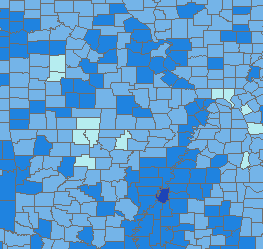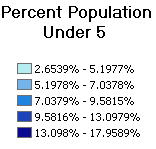Geometrical interval |
|
|
Release 9.2
Last modified August 15, 2007 |



|
This is a classification scheme where the class breaks are based on class intervals that have a geometrical series. The geometric coefficient in this classifier can change once (to its inverse) to optimize the class ranges. The algorithm creates these geometrical intervals by minimizing the square sum of element per class. This ensures that each class range has approximately the same number of values with each class and that the change between intervals is fairly consistent.
This algorithm was specifically designed to accommodate continuous data. It produces a result that is visually appealing and cartographically comprehensive.


What is a geometric series?
A geometric series is a pattern where a constant coefficient multiplies each value in the series. For example, a sequence of {0.1, 0.3, 0.9, 2.7, 8.1} is where each value is multiplied by 3. The inverse of 3 would be 0.33333 (or 1/3).
The table below is an example of a geometrical interval classification that was produced in ArcMap. The interval (or bin size) of the class is calculated by subtracting the minimum from the maximum. The geometric coefficient is calculated by dividing the previous interval by the current interval. There are two possible geometric coefficients to create this classification structure, 1.539927 and 0.649382, which are inverses of each other.
| Minimum | Maximum | Interval | Coefficient |
| 0.026539462 | 0.046593756 | 0.020054 |
|
| 0.046593757 | 0.059616646 | 0.013023 | 1.539927 |
| 0.059616647 | 0.068073471 | 0.008457 | 1.539927 |
| 0.068073472 | 0.081096361 | 0.013023 | 0.649382 |
| 0.081096362 | 0.101150655 | 0.020054 | 0.649382 |
| 0.101150656 | 0.132032793 | 0.030882 | 0.649382 |
| 0.132032794 | 0.179589017 | 0.047556 | 0.649382 |